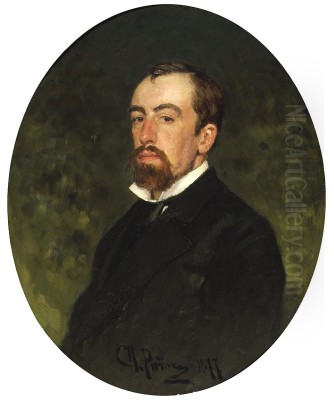
Vasily Dmitrievich Polenov stands as a monumental figure in the landscape of Russian art. A master painter renowned for his evocative landscapes, historical scenes, and genre paintings, he was also a man of diverse talents, excelling as a musician, architect, and influential educator. His life and work are deeply intertwined with the flourishing of Realism in Russia, leaving an indelible mark on the generations of artists who followed him. Born into a milieu of culture and intellect, Polenov dedicated his life to the pursuit of beauty and truth, earning him the affectionate title "Knight of Beauty."
Early Life and Formative Education
Vasily Polenov was born on June 1, 1844, in St. Petersburg, into a prosperous and highly cultured family. His background provided a fertile ground for his burgeoning artistic inclinations. His father was a noted historian, archaeologist, and bibliographer, serving as the secretary of the Russian Archaeological Society, while his mother was a writer and amateur artist, herself hailing from an esteemed family connected to the arts. This environment, rich in history, literature, and art, undoubtedly shaped Polenov's worldview and aesthetic sensibilities from a young age.
His formal artistic training began at the prestigious Imperial Academy of Arts in St. Petersburg, where he enrolled in 1863. He studied there until 1871, benefiting immensely from the tutelage of Pavel Chistyakov, a highly respected painter and pedagogue known for his rigorous academic methods. Chistyakov's emphasis on drawing, composition, and a deep understanding of form provided Polenov with a solid technical foundation that would serve him throughout his career. During his time at the Academy, Polenov proved to be a gifted student, eventually earning accolades for his work.
European Travels and Artistic Influences
Like many aspiring Russian artists of his time, Polenov sought to broaden his horizons through travel and study in Europe. After graduating from the Academy, he embarked on a journey abroad, spending significant time in Italy and France. These years were crucial for his artistic development. He immersed himself in the masterpieces of European art, absorbing the lessons of the Old Masters while also engaging with contemporary artistic currents.

In France, Polenov encountered the burgeoning Impressionist movement and the established traditions of Realism. While he remained rooted in his academic training, the European experience, particularly the emphasis on light and color seen in French painting, subtly influenced his approach. He was particularly struck by the work of artists like the French Orientalist painter Henri Regnault, whose art he may have encountered at the Vienna World's Fair in 1873. This exposure encouraged Polenov to experiment with a brighter palette and a more direct, observational approach to painting.
A significant, albeit brief, trip to London in 1875 also left a lasting impression. The vibrant, complex life of Victorian London, coupled with an exposure to Orientalist styles prevalent at the time, sparked an interest in Middle Eastern and biblical themes that would become prominent in his later work. His European sojourns equipped him with new techniques and perspectives, which he skillfully integrated into his uniquely Russian artistic vision upon his return home.
Pioneer of Plein Air Painting in Russia
Upon returning to Russia, Vasily Polenov became one of the first and most significant proponents of plein air painting – the practice of painting outdoors, directly from nature. This approach, gaining traction in France with the Impressionists, was relatively novel in Russia. Polenov embraced it wholeheartedly, believing that capturing the fleeting effects of natural light and atmosphere required direct observation.
His commitment to plein air revolutionized Russian landscape painting. He moved away from the idealized, often studio-bound landscapes of earlier generations, seeking instead a more authentic and immediate connection with the Russian countryside. His canvases began to radiate with natural light, fresh color, and a palpable sense of atmosphere, capturing the subtle nuances of the changing seasons and times of day. This dedication to painting outdoors lent his landscapes a remarkable freshness and vitality.
Artistic Style and Philosophy: The Pursuit of Beauty
Polenov's artistic style is characterized by a harmonious blend of Realism and a lyrical, almost Romantic sensibility. While grounded in accurate observation and faithful representation, his works are imbued with a profound sense of poetry and emotional depth. He possessed a remarkable ability to capture the interplay of light and shadow, using a rich and nuanced palette to convey mood and atmosphere. His landscapes, in particular, are celebrated for their tranquility and their affectionate portrayal of the Russian land.
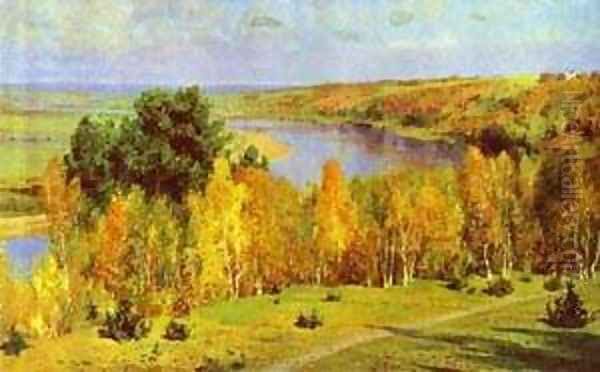
He was driven by a deeply held belief in the power of art to elevate the human spirit. Often referred to as the "Knight of Beauty," Polenov saw his mission as bringing joy, happiness, and enlightenment to people through his creations. This philosophy permeated his work, whether depicting the quiet charm of a Moscow courtyard, the golden hues of autumn, or scenes from biblical history. He sought beauty not just in the grand or dramatic, but also in the simple, everyday moments of life and nature.
The Peredvizhniki Movement and Contemporaries
Vasily Polenov became closely associated with the Society for Travelling Art Exhibitions, better known as the Peredvizhniki (the Wanderers). This influential group of Russian Realist artists sought to break free from the constraints of the academic establishment and bring art closer to the people by organizing travelling exhibitions across Russia. Polenov joined the Peredvizhniki in 1878, sharing their commitment to depicting contemporary Russian life and landscape with truthfulness and social awareness.
Within the Peredvizhniki circle, Polenov maintained close relationships with leading figures of Russian Realism. He collaborated and exhibited alongside prominent artists such as the master landscape painter Ivan Shishkin and the influential portraitist and historical painter Ivan Kramskoy. His interactions with these artists fostered a stimulating environment of shared ideas and mutual support, contributing significantly to the strength and dynamism of the Realist movement in Russia.
One of Polenov's most significant contemporaries and friends was the celebrated painter Ilya Repin. Both artists studied at the Academy around the same time and both achieved great recognition, even sharing the Great Gold Medal upon graduation for their respective historical paintings. Their careers often intersected, and they held a deep mutual respect. While both were key figures in the Realist movement, their relationship appears to have been marked more by camaraderie and shared artistic goals than by intense rivalry. Polenov also maintained connections with other important artists like the renowned painter of battle scenes and ethnographic subjects, Vasily Vereshchagin, whose work, particularly its realism and engagement with historical themes, resonated with Polenov's own interests.
Polenov's influence extended beyond direct collaboration. His artistic gatherings, such as the "Painting Days" and "Watercolor Mornings" held at his home, attracted younger artists and fostered a sense of community. Figures like Konstantin Savitsky were known to frequent these sessions. Furthermore, some accounts suggest his work later held significance for artists exploring new directions, including Vasily Kandinsky, who would become a pioneer of abstract art. Polenov's interactions with his peers were thus characterized by a spirit of shared purpose and mutual inspiration, contributing to the rich tapestry of late 19th-century Russian art.
Masterpieces of Landscape Painting
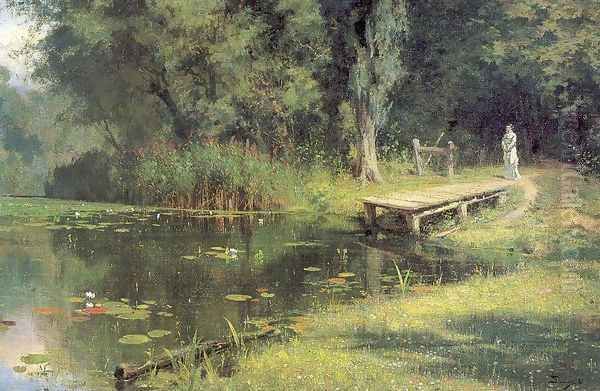
Landscape painting remained central to Polenov's oeuvre throughout his career, and it is perhaps for these works that he is most beloved. He possessed an extraordinary sensitivity to the nuances of the Russian landscape, capturing its quiet beauty and poetic charm with unparalleled skill. His landscapes are not merely topographical records; they are imbued with human presence and feeling, often suggesting a harmonious relationship between humanity and nature.
Among his most famous landscapes is Moscow Courtyard (1878). This iconic painting depicts a sun-drenched, tranquil scene of everyday life in a Moscow neighborhood, capturing the atmosphere of a warm summer day with remarkable freshness and intimacy. It became an instant classic, celebrated for its authenticity and its affectionate portrayal of ordinary Russian life.
Other significant landscape works include Grandmother's Garden (1878), another intimate scene filled with nostalgia and warmth, depicting figures amidst the lush greenery of a country garden. Golden Autumn (1893) showcases his mastery of color and light, capturing the radiant beauty of the Russian autumn landscape with breathtaking lyricism. Works like Ferry on the Oyat River demonstrate his ability to capture the specific character of different regions and the interplay of water, light, and human activity. His time spent painting in Europe also yielded notable works, such as Fishing Boats at Étretat, reflecting his engagement with international artistic trends while retaining his unique vision.
Exploring Historical and Religious Themes
Beyond landscape, Polenov made significant contributions to historical and religious painting. His approach to these genres was marked by a desire for historical accuracy combined with profound psychological insight and emotional depth. He undertook extensive research and travelled widely, particularly in the Middle East, to gather authentic visual material for his biblical compositions.
His travels to Egypt, Palestine (including Jerusalem), and Syria in 1881-1882 were pivotal. He meticulously sketched landscapes, architectural details, and local people, seeking to reconstruct the historical setting of biblical events with unprecedented realism. This commitment to ethnographic and historical accuracy set his religious works apart from more traditional interpretations.
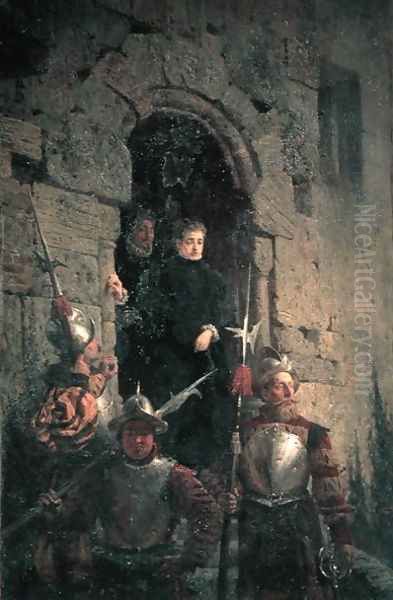
One of his most ambitious and celebrated works is the large-scale painting Christ and the Sinner (also known as Jesus and the Sinful Woman), completed in 1888 after many years of preparatory work. The painting depicts the New Testament scene with a focus on human drama and psychological nuance, set against a meticulously rendered backdrop based on his Middle Eastern studies. The work was hailed for its innovative approach, presenting Christ and the figures around him as real, historical individuals, imbued with complex emotions. Another significant work in this vein is Christ among the Doctors, which similarly reflects his deep engagement with the Gospel narratives and his quest for historical veracity combined with powerful emotional expression.
A Dedicated Teacher and Mentor
Vasily Polenov was not only a prolific artist but also a highly influential teacher. From 1882 to 1895, he served as a professor at the prestigious Moscow School of Painting, Sculpture and Architecture. During his tenure, he mentored a generation of artists who would go on to become leading figures in Russian art. His teaching methods, like his art, emphasized direct observation, technical skill, and the importance of capturing the "truth of vision" – a faithful yet emotionally resonant depiction of the world.
His studio became a vibrant center of artistic learning and experimentation. Among his most famous students were Isaac Levitan, who would become arguably Russia's greatest landscape painter, deeply influenced by Polenov's lyrical approach to nature. Konstantin Korovin, another prominent student, became a leading Russian Impressionist. Other notable artists who studied under Polenov include the Symbolist painter Mikhail Nesterov, the Realist Abram Arkhipov, the versatile designer and painter Alexander Golovin, the artist associated with the Neo-Russian style Sergei Malyutin, and painters like Vasily Meshkov, Nikolai Roskov, Yeghishe Tadevosyan, Ivan Leontiev, and Anatoly Abramchuk.
Polenov's impact as an educator was profound. He fostered a supportive yet rigorous environment, encouraging his students to develop their individual styles while grounding them in the fundamentals of realistic representation and the importance of plein air work. His legacy as a teacher is evident in the remarkable achievements of his many pupils, who significantly shaped the course of Russian art in the late 19th and early 20th centuries.
Multifaceted Talents and Later Life
Polenov's creativity extended beyond the canvas. He was a gifted amateur musician, composing music and participating in musical evenings. His interest in architecture led him to design his own estate, Borok, located on the scenic banks of the Oka River near Tarusa. He designed the main house and other buildings, creating an environment that reflected his artistic ideals. He was also involved in theatre design, contributing sets for productions at Savva Mamontov's Abramtsevo Colony, a renowned artistic community where Polenov was a frequent visitor and active participant.
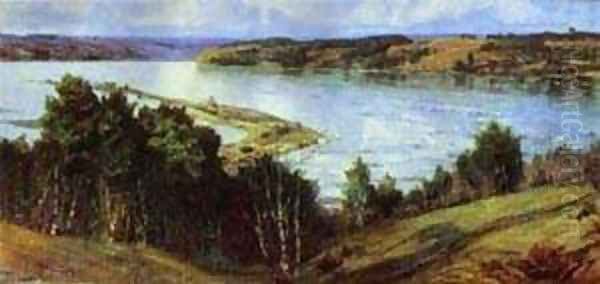
In his later years, Polenov increasingly spent time at his beloved Borok estate. He continued to paint, focusing on the surrounding landscapes and themes close to his heart. The estate became a cultural hub, attracting artists, writers, and musicians. Even after the Russian Revolution, Polenov remained dedicated to art and culture, working to preserve artistic heritage and promote education. His international reputation endured; his works were included in the significant Exhibition of Russian Art held in New York in 1924, showcasing his art to an American audience. An anecdote from this period highlights his characteristic humility: when a collector remarked on the surprisingly low prices Polenov asked for his works at the exhibition, he humorously referred to the artist as a "cunning Russian," perhaps misunderstanding Polenov's lack of commercial aggressiveness.
Vasily Polenov passed away on July 18, 1927, at his Borok estate. True to his wishes and legacy, the estate was preserved and eventually became the Polenovo State Museum-Reserve, dedicated to his life and work, ensuring that his artistic spirit continues to inspire visitors.
Enduring Legacy
Vasily Polenov's contribution to Russian art is multifaceted and enduring. As a painter, he revolutionized landscape painting, bringing a new level of intimacy, light, and poetic feeling to the depiction of the Russian countryside. His historical and religious paintings offered innovative interpretations, grounded in research and imbued with psychological depth. As a member of the Peredvizhniki, he played a vital role in the development of Russian Realism.
Perhaps equally important was his role as an educator. Through his teaching at the Moscow School, he nurtured the talents of a generation of artists who would define Russian art at the turn of the century. His emphasis on direct observation, technical mastery, and the pursuit of beauty and truth left an indelible mark on his students and, through them, on the broader course of art history. Vasily Polenov remains a revered figure, celebrated for his artistic achievements, his diverse talents, and his unwavering dedication to the ennobling power of art.